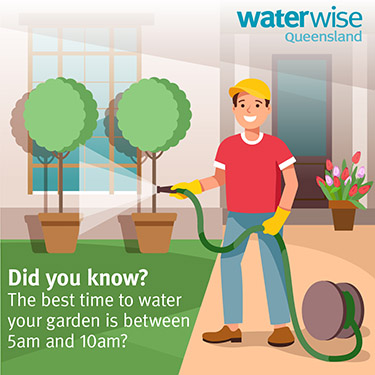
Water-efficient gardens require less maintenance. Some tips on how to be a waterwise gardener (PDF, 563KB) include:
When installing an outdoor irrigation system, the Queensland Plumbing and Wastewater Code requires it to be water efficient. To help you fulfill this requirement, we’ve developed some guides on establishing and maintaining water efficient gardens (PDF, 1.4MB) and active playing surfaces (PDF, 687KB).
Checklists are also available for home gardens (PDF, 143KB) and active playing surfaces (PDF, 95KB).
You can also read the full efficient irrigation guidelines (PDF, 6MB) for more detail.
Gardening expert, Costa Georgiadis, believes the guidelines are a great for sharing ways to have water-efficient gardens.
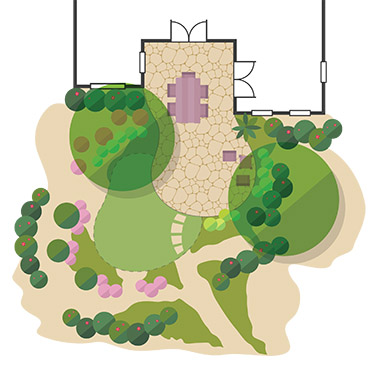
When planning your landscape and irrigation system, you should consider the following elements:
One of the main keys to saving water is to know and improve your soil. You can improve your garden’s soil and water efficiency by mulching, and by adding organic matter or wetting agents.
When planting or laying grass for the first time, make sure you choose one that is suitable for the Queensland climate and that is water-efficient. Choose your plants based on the climate and soils of the area. Planting hardy shrubs and drought-tolerant plants will help save water.
Different plants need different amounts of water. It is recommended that you design your landscape so plants are grouped together based on their water, soil and sun requirements. Preferably, each zone will have plants with similar water requirements.
Identify areas where shady trees, shade sails, pergolas or other structures could be incorporated into your plan.
Strong winds can increase evaporation so consider providing windbreaks to protect your plants.
For more detailed guidance, refer to the following checklists:
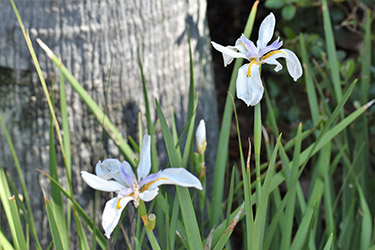
Planting hardy shrubs and drought-tolerant plants will help reduce your water needs. Choose your plants based on the climate and soils of the area.
When buying plants, look for ones with these features:
Examples of plants that will tolerate dry conditions, once established, and also tolerate some moisture:
Please consider the suitability of plants for your garden as some may be classified as weeds in your council area, and some are not as child or pet friendly as others.
Contact a nearby nursery or your local council for information on waterwise plants suited to your local area.
The key to establishing and maintaining a water-efficient garden is understanding your soil. Soils with high water-holding capacity, ample depth, effective infiltration and good drainage need less frequent watering and make best use of available rainfall.
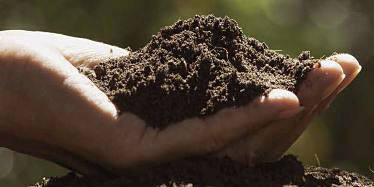
Firstly, determine the soil type based on its texture. The three main textures are clay, sand and loam. There is a simple test you can use to check the soil’s texture.
Clay has fine, dense particles that do not allow water to soak in easily. Clay soils take water slowly, so it’s best to water deeply and slowly at long intervals. When clay soils are dry, they can become hard and resist water. However, when wet, they can hold moisture for a long time, so you might not need to water again for a while.
To improve clay, dig up the soil to a depth of 30cm in your garden beds if possible (make sure the soil is not very dry or very wet when you do this). Some clay soils benefit from adding gypsum or dolomite to this depth.
Next, dig in plenty of organic material such as compost or manure. Then add a layer of organic mulch.
While these soils have low moisture and nutrient-holding capacity, they are usually well aerated and easy to cultivate.
They can be hard-setting with poor infiltration once they have dried out, so using a wetting agent may help. Digging in plenty of organic matter will also improve sandy soils by adding nutrients and increasing water holding capacity.
Loam refers to any soil that is between sand and clay soils. Loams are considered to be the best soils for growing plants.
Like all soils, loams can be improved and maintained by adding organic matter such as compost and manure.
Water deeply and infrequently. Applying wetting agents may also help the soil better absorb water.
Read more about how to identify and improve your soil (PDF, 563KB).
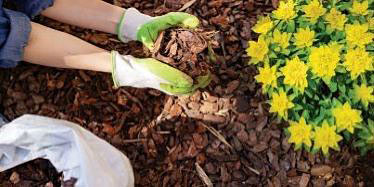
Mulching is an essential element of a water-efficient garden. Mulching around plants saves water by reducing evaporation and run-off. Depending on the type of mulch, it limits weed growth and can improve soil conditions by adding nutrients. Mulching also protects plant roots from high temperatures and soil from erosion.
There are many different types of mulch to choose from.
Organic mulch, such as sugar cane, grass clippings, leaves or pine bark, breaks down over time and improves your soil. Organic mulch needs to be topped up frequently, preferably in autumn and spring.
Coarse organic mulch, which allows water to infiltrate more easily, is good for reducing weeds and keeping soil cool, but it will not improve the soil’s texture as the mulch does not readily break down.
Organic mulch made of fine particles (such as grass clippings) can improve the soil’s texture as it breaks down more easily; however, it is more prone to compaction so will need to be loosened regularly to ensure water penetration.
Inorganic mulch, such as rocks and pebbles, helps to reduce evaporation but doesn’t improve the soil.
For the best result, prepare the soil by removing weeds, raking or digging the surface and watering the remaining plants. Place a layer of newspaper over the soil to deter weed growth, but make sure it’s not too thick as it will reduce air supply to the soil.
The ideal thickness of the mulch layer depends on the particle size of the mulch material. If using large chunks, such as pine bark, a deeper layer (more than 5 cm) is needed. Mulch made of fine particles is more prone to compaction so it should be applied in a thinner layer of around 2 cm.
Be sure to keep the mulch about 6-7cm clear of plant stems or they may rot.
As organic mulch decomposes it can draw nitrogen from the soil. Watch your plants for signs of nitrogen deficiency (usually indicated by yellowing of the lower leaves) and use a nitrogen-rich fertiliser if needed.
Follow these tips to grow a healthy lawn without wasting valuable water.
When planting or laying grass for the first time, be sure to choose a species that tolerates dry conditions and is suited to your soil type. A variety of commercially available grasses are suitable for the Queensland climate and are water efficient, including Buffalo, Couch, Kikuyu and Zoysia.
The greatest waste of water comes from applying too much, too often—much of it runs off. Water less frequently and more deeply to encourage a deeper root system which provides greater drought protection.
Signs that your grass is ready for irrigation include the following:
If you observe bright-green patches in your grass or the presence of fungus (toadstools) or moss, you may be overwatering. The efficient irrigation guidelines (PDF, 6MB) provide tips for growing a healthy lawn without wasting valuable water.
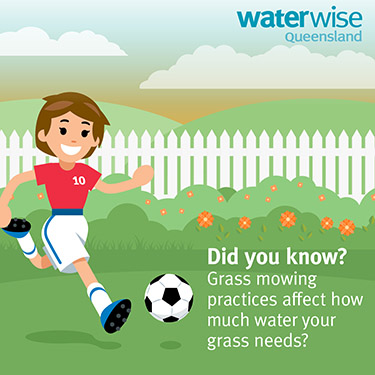
To prevent grass from drying out, keep it at least 3 cm high. This will minimise evaporation from the soil underneath and ensure the roots are sheltered from the harsh sun. Avoid mowing during the hottest part of the day.
Regularly check your mower blades for wear, as grass will lose less water if it is cleanly cut rather than torn by blunt blades.
If you are fertilising your lawn, use small amounts of an organic fertiliser as this requires less water after application than a chemical fertiliser. Apply fertiliser during the spring and summer months when there is higher rainfall and the grass is actively growing.
The amount of water your garden needs depends on many factors including:
Follow these simple guidelines to save water and enjoy a sustainable, water-efficient garden and check out our hints on watering in this video.
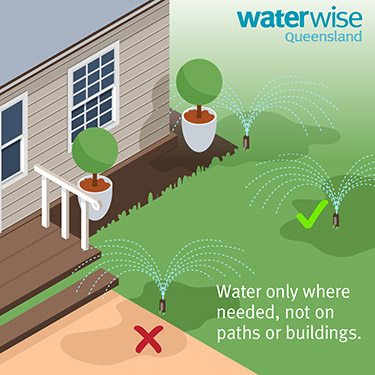
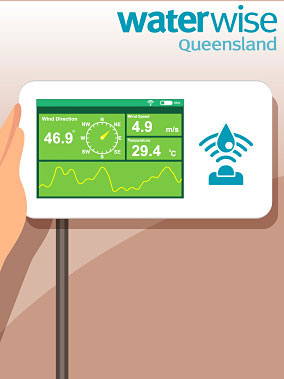
The greatest waste of water comes from applying too much, too often—much of it runs off and never soaks in. Water at a slower rate, for a longer time and less frequently.
Instead of watering the entire garden, just water the plants that need it. Many plants are much tougher than you think and will go for quite long periods without additional watering. This also has the effect of training your plants to be more resilient. Less-frequent watering forces roots down to find water, making the plants less reliant on surface water, and better able to cope with hot, dry days.
Overwatering can cause waterlogging of the soil and can contribute to plant disease. The best way to tell if your garden needs watering is to check the soil moisture. You can do this either by using a soil moisture meter, by digging a hole to the root zone, or using a screwdriver to make sure it can easily go to about 10 cm (100 mm) depth.
Grass may benefit from more infrequent but thorough soakings to encourage deep roots. Trees and shrubs have much deeper and more extensive root systems, so they should be watered less frequently but for longer periods of time.
It is likely your plants need water if the leaves or stems of your plants are droopy, or the edges of the leaves are turning brown, and the soil is dry.
Try to water between 5 am and 10 am—when the sun is low, winds are calm, and temperatures are cool. Less water is lost to evaporation and wind during this time. Irrigation in the evening, while there is low evaporation, can lead to fungus growth as leaves can remain wet overnight. By irrigating in the morning, you give the leaves a chance to dry out during the day.
Before watering, check the weather forecast. If it is about to rain, don’t water. If you have a rain gauge, use it to determine the rainfall received and whether additional watering is needed.
Check with your local water service provider or council about water restrictions and only water your garden when permitted.
Your irrigation system should be set up so that it can deliver the right amount of water to the right places.
You should select an irrigation system and emitters that are appropriate for your:
Advice on how to use different irrigation devices and design irrigation systems can be found in the efficient irrigation guidelines (PDF, 6MB). Hear what gardening expert Costa Georgiadis has to say about the guidelines.
You can seek professional expertise on irrigation system design, installation and maintenance from a horticulturist, landscaper, or certified irrigation professional. Advice on plumbing and drainage requirements is also available from your local water service provider or council.
Depending on the typical weather patterns in your area, consider installing a rainwater tank for use in your home and garden — there are shapes and sizes to suit most properties. Further details on selection, installation, maintenance, mandatory requirements and council regulations can be found in the rainwater tanks brochure (PDF, 3.4MB).
Greywater is waste water generated from baths, showers, washbasins and laundries. You can reuse your water by using greywater on your lawns and gardens, however it is important to use it carefully. Check with your local council if council has any regulations for its use. If using greywater on your garden, it is preferable to use biodegradable detergents in the home that are low in sodium, phosphorus and nitrogen; they are better for your garden and the environment. Greywater must be used immediately but avoid using on vegetable gardens, herbs or edible plants.
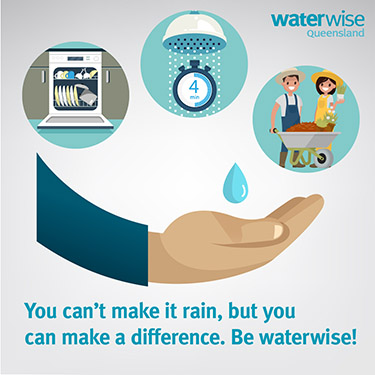
Waterwise gardening, 04 Jun 2025, [https://oss-uat.clients.squiz.net/environment/water/residence/use/garden]
This document is uncontrolled when printed. Before using the information in this document you should verify the current content on https://oss-uat.clients.squiz.net/environment/water/residence/use/garden.